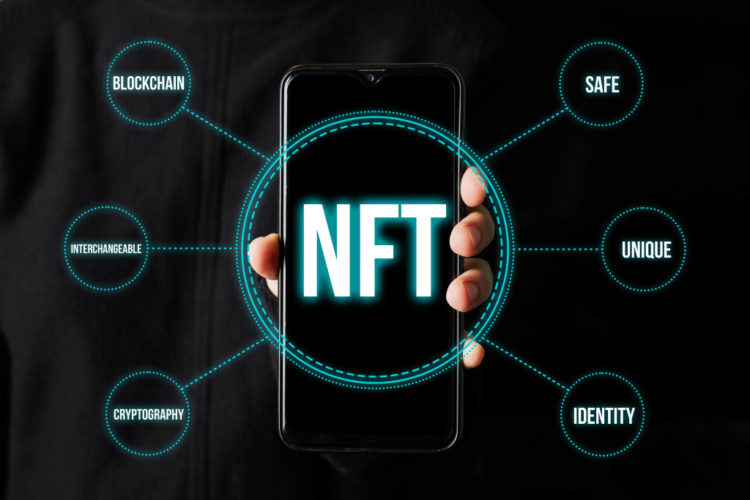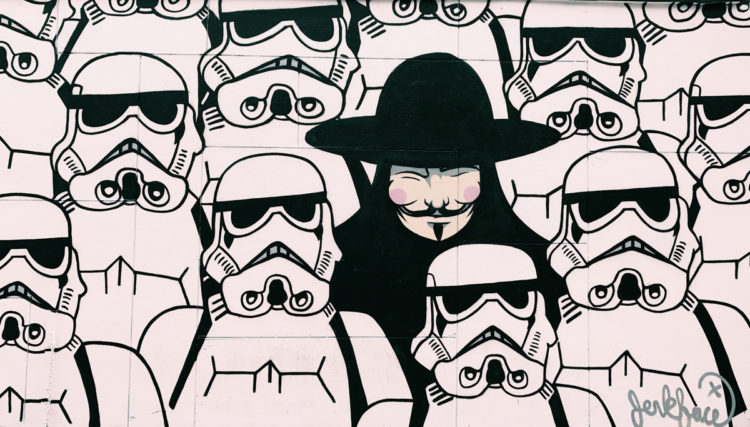In this guide, I explain if and how you can earn money by selling your photos (or videos) as NFT.
PS: I just published a review of the Sloika marketplace. If you’re already familiar with the NFT world but are looking for a marketplace to start selling your images as NFT check out my article.

After the news of a JPG file being sold at auction for the incredible sum of $69 million, NFTs exploded in popularity.
Some think this is yet another speculation related to cryptocurrencies. Others think this technology is here to stay and it is one of those innovations that can change the world, a bit like it was for the Internet.
Regardless of what people may think, it’s only fair to get informed and see if there’s actually any use for it, especially for those who, like me, already make money from selling stock photos and video footage (here’s my guide).
This article is written for those who do not have much technical knowledge on the subject. I tried to explain things as simple as possible. Keep in mind, however, that we are in the early stages of adoption of this technology, so it is a complicated subject, everything is changing very quickly and for the moment there is no real regulation of the market. This means that there are questions that for now have no answers.
What is a NFT?
![]()
Wikipedia gives this definition:
A non-fungible token (NFT) is a unit of data on a digital ledger called a blockchain, where each NFT can represent a unique digital item, and thus they are not interchangeable. NFTs can represent digital files such as art, audio, videos, items in video games and other forms of creative work. The NFTs can be bought on an NFT market.
Are you confused? To be honest the language used is quite technical and difficult to understand for those approaching this world for the first time.
Let’s take a step back. To understand what an NFT (non-fungible token) is, it’s better to give an example of what an NFT is NOT.
A fungible object (FT) is an object that is completely interchangeable with another belonging to the same category. A very simple example is the €10 bill. Every €10 bill in circulation has the same value, no matter where it came from, who gave it to you, or how long it has been in circulation. With any €10 bill, you can always buy goods equivalent to their face value. If your €10 bill is stolen, you can earn another €10 bill and “replace” it without any problem and without anyone noticing.
An NFT on the other hand has three main characteristics:

- Unique and verifiable identity
- Demonstrable scarcity
- Indivisibility
A simple example of NFT is pets. Let’s assume that I have a dog named Snoopy. Snoopy is unique. There is only one in the world. He is indivisible and if I were to replace him with another dog, he would no longer be him. Dogs are not interchangeable and therefore are an example of something not fungible.
Another example of NFT is limited edition cards. Unlike Snoopy, some cards have multiple copies, but they still have a serial number that identifies them individually. Obviously, animals, are not collectible items but the example serves to make you understand that each NFT is as unique as Snoopy is.
What determines the value of an NFT?

NFTs are just the latest materialization of an obsession that is part of human psychology: collecting objects. However, there is no universal rule to determine the value of a collectible object. There are some parameters used to understand if an object has a value such as its rarity, provenance, and quality. But the value is still determined by how much people are willing to spend, as simple as that. If you think the photo mentioned above that was sold for $69 million doesn’t make any sense you’re probably right. But someone was willing to spend that money and that is its value.
Until recently, this exchange of objects was limited to physical goods such as paintings, stamps, phone cards, etc. and it was not possible to replicate the parameters mentioned above (rarity, origin, and quality) in the digital world. After all, every digital file can be replicated with a simple copy/paste, thus invalidating the concept of scarcity and unique and verifiable identity.
The NFT revolution
The real revolution of NFTs consists in having overcome for the first time this limitation (only physical assets could be non-fungible) thanks to the use of blockchain technology. I don’t want to go into details and explain what a blockchain is and how it works because it would require a dedicated article (you can find the definition on Wikipedia here). The point is that NFTs work thanks to the blockchain, the same technology behind Bitcoin, but used for a different purpose.
- Smart Contracts (computer programs running on the blockchain) can determine that for example there will only be X copies of a file, thus creating the first prerequisite for the existence of an NFT: demonstrable scarcity.
- Blockchain makes it possible to trace every single transaction since the addresses of each block are public and the blocks are all connected (hence the name blockchain). This then creates another prerequisite for the creation of an NFT: unique and verifiable identity. In fact, it is possible to verify that it was truly created by the artist and each NFT produced is unique, since it has a sort of digital serial number.
Use of NFTs

NFTs have become very popular mainly in the world of video games since they allow people to exchange rare collectible items (such as weapons) outside of the markets created by software developers. A few years ago, for example, the CryptoKitties craze exploded. The same concept can be applied to any type of digital file including music, photos, videos, and even Tweets.
When I first started learning about the world of NFTs, I immediately wondered if it was possible to use them to sell photos (and stock footage), especially since agencies like Shutterstock keep reducing the commissions for the photographers.
Having control of your own work and being able to determine how many copies to sell and at what price seemed like a very interesting idea.
The first comparison that came to my mind is with stock agencies that allow you to sell your photos exclusively, thus creating a sort of scarcity of your own work. But, even though there are some similarities, NFTs are very different.
The world of NFTs is much closer to the world of auction houses.
NFT pros and cons

These are some of the pros and cons I’ve thought about while keeping in mind the use of NFTs to sell photos and videos. As time goes on and technology matures things will change, probably for the better.
Secondary market: perpetual commissions
Once an NFT is created, the artist will earn commissions every time the file is sold to someone else. To give an example, it is as if a painter could collect commissions every time the painting is sold at auction to a new collector. The total number of copies and the amount of commissions are determined when the NFT is created (this process is called minting). The commissions will be paid directly in cryptocurrency (most often in Etherium).
Upfront cost
Creating an NFT, minting the file, has a cost, in cryptocurrencies. The type of cryptocurrency is dictated by the type of blockchain used. In some cases, you will be spending Ethereum, in others Binance Coin in other cases Ada. However, the list of NFT coins is getting longer and longer as you can see here.
Keep in mind that just like with classic stock agencies there is no guarantee that the file will be sold. This creates a big problem because using Ethereum, for example, minting a file can be very expensive (it can be normal to spend up to 50€ or more for a single file). The reason is related to the Ethereum blockchain and, even if an update is coming, there is no guarantee that things will improve substantially. Other blockchains (such as Binance Smart Chain) have much lower costs but still, you do have to pay for every single file you mint. It’s unthinkable then to upload thousands of photos, as it’s common with classic stock agencies, waiting for them to be sold.
Technological Gap
The biggest limitation of NFTs is that it’s currently fairly difficult for many people to start creating them. First and foremost, you have to buy cryptocurrencies. Although there are increasingly popular tools, such as Binance or Coinbase, the concept of buying and selling these coins is itself a barrier for most people. I regularly get requests for help from people who don’t understand how to use sites like Eyeem. I can imagine the difficulties many will have trying to use cryptocurrency trading apps and digital wallets.
Once you have purchased the coins you need to transfer them to a digital wallet such as Metamask (making sure to use the right blockchain address). Then you have to connect the digital wallet to one of the sites that allow you to exchange NFT such as Opensea.io. Once done that, you can upload the digital file and mint it by paying the commission.
In short, as you can see, it’s a very complex process, unlike stock agencies where, in just a few minutes, you are ready to upload and sell your photos. The other side of the coin is obviously the fact that this barrier, for now, creates less competition, and whoever enters the market first has a better chance to succeed.
As time goes on, the process will surely be simplified.
Direct relationship with the customer
The biggest difference between the classic stock agencies like Getty, Alamy, etc, and marketplaces that allow you to sell NFTs is that the value of the work is decided by the artist (or through an auction) and not by the agency itself. Also, there are no middlemen who take most of your earnings in commissions. Typically, photo agencies keep between 50% and 70% of the sale price in commissions. NFT platforms keep a small commission but it is really low (around 2/3 %).
With NFT you have a cost to create the file, but the cost is related to the blockchain used and not to the site used to sell the work. After the initial cost, you can keep all the earnings (if and when you manage to sell the file). The downside (quite big honestly) is that it is up to you to promote your work.
Selling photos as NFT is more similar to using platforms like eBay than microstock agencies. You put a digital file for sale, but there’s no guarantee that there will be people interested in your work, and you may end up just spending money instead of making money.
What are the differences between the various platforms?

Although the end goal is still the same (to create NFTs and have a virtual space to sell them), there are substantial differences between the various sites.
The first big difference is that there are two main categories of marketplaces:
- Curated marketplaces: the team behind the website decides if and who can become an approved artist and they also require exclusivity (like some photo agencies). SuperRare, Nifty Gateway, and Sloika are all examples of this kind of websites. Here’s my review of the Sloika marketplace. Here you can check out my first NFT series for sale on Sloika.
- Open marketplaces: anyone can upload and mint NFT. Rarible and OpenSea are open.
The exclusivity given to curated marketplaces is NOT on the artist, but on the artwork, so even if you were to give exclusivity to SuperRare you can upload different works on Rarible (at least in theory but it would not make much sense as you’ll see later).
The second distinction is about the types of sales allowed on the platform.
- Some, such as SuperRare, work like eBay or auction houses. At the end of a specific period of time, whoever placed the highest bid gets the work.
- Other sites such as Nifty Gateway allow you to sell, to drop, the artwork in a more complex way: you can decide whether to make auctions, open editions, silent auctions or limited editions.
FAQ about NFTs and photography sales

If I have to be honest for now there are more questions than answers. Some of the doubts I had were answered after I personally contacted some agencies. Other questions simply have no answers, at least for now.
Can I sell a photo I uploaded to Shutterstock (or any other agency) as NFT?
There are currently no laws or regulations prohibiting this practice. The rules are dictated by the marketplace you use to create and sell the NFT. Some websites don’t have rules, others do.
Beyond the written rules remember the ideal behind NFTs: the value is tied to the uniqueness of the work and its scarcity. Does it make sense to sell a file on Shutterstock and then create an NFT? Keep in mind that those who buy NFTs are theoretically collectors. They are the ones who value the work by deciding to buy it. If it turns out that an artist is “cheating” what kind of sales prospects do you think he will have? Would you buy a stamp for 1000€ (just to give you an example) knowing that you can buy the same stamp for 1€ in a different store? If you wouldn’t, what makes you think others would?
Can I create an NFT on every available Blockchain?
The answer is pretty much the same as before. There are currently no limitations but does it make sense to do this? The more common an object is, the less valuable it is, not the other way around. It’s against your interest to create copies of your work on different blockchains. The question is legitimate since in stock photography it’s often good to sell the same photos on different platforms (unless you have given exclusivity to an agency). In the NFT world, this doesn’t make much sense.
What are people doing with NFTs?
There are two categories of people who buy NFTs: speculators and collectors.Speculators buy hoping to resell at a higher price. Collectors, on the other hand, buy because they appreciate the artist and the work he has created.
There is also a market for devices that are used to reproduce NFTs (such as digital picture frames, etc.) and there are virtual worlds in which galleries, museums, private homes, virtual spaces, are set up with NFTs. However, the whole thing is very abstract and I understand that it can be difficult to understand it completely.
Final remarks on NFTs and the world of photography

After this, lengthy, article the question that interests you the most is probably only one: can I make money selling photos like NFT?
The answer is: it’s up to you. The NFT world is perfect if you create limited edition digital artwork. Whether it’s paintings, photos, videos, or anything else the price is tied to the scarcity of the file and to the reputation of the artist. This is perhaps the hardest part thing to achieve: creating a community that appreciates the person behind the artworks and knows how to value them. At least this is how the NFT market works at the moment. I wouldn’t be surprised if in the future things will change and even stock photography agencies start to adopt this technology in some way.
If you already sell microstock or stock footage (best agencies here) starting to sell NFT requires a change of mindset. You can’t upload thousands of pictures like you’d do on Shutterstock because this has a cost. Better to focus on a few works of the highest quality possible. Beeple (the artist behind the photo that sold for $69 million) sold his work at a very high price because it took him years to complete it (over 13 years).
If you are a fine art photographer and until now you have had difficulty monetizing your work maybe NFTs can be the turning point for your career. If like me, you are a travel photographer, you do reportage, or simply stock photography, at the moment NFTs are probably not yet ideal.
If you’ve already created and sold your first photo as an NFT leave me a comment and tell me about your experience. I’ll be happy to include it in the article if it’s helpful to other photographers.
Join our community
Contact Us
Email : contact@fudxcoin.com
Web : https://www.fudxcoin.com
Office:
US : 1309, Coffeen Ave Ste 1200 sheridan WY 82801
UK : 127 Fencepiece Road, Ilford, Essex, United Kingdom, IG6 2LD

